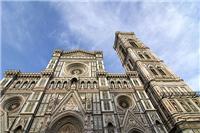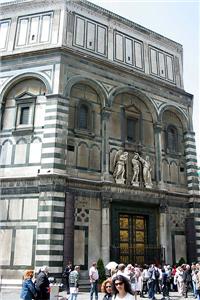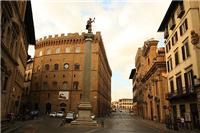The walking tour of Florence is a three-hour stroll through 2000 years of history!
Don't miss out on the unforgettable experience of a leisurely walk through museums filled with renaissance works of art; down winding medieval passages where Dante, Boccaccio and Petrarch lived and laid down the foundations of the Italian language; along the banks of the romantic Arno, the river that cuts across Florence; over the Pontevecchio, which joins the two riverbanks and which houses superb artisan and goldsmith shops; around and inside gorgeous churches and cathedrals, designed and decorated by some of the world's most famous artists and where legendary historical figures from Foscolo to Machiavelli and Galileo have been laid to rest.
During the tour, you'll be able to visit:
Chiesa di Santa Maria Novella and its Piazza
A marvelous example of gothic architecture, this church was constructed by Dominican monks from 1246 to 1360. The facade, designed by Leon Battista Alberti, was completed towards the end of the 15th century. It is located in front of the city's train station and is a great meeting place for starting your tour of Florence.

Florence Cathedral and Giotto's Campanile
The gorgeous Piazza del Duomo houses the Florence Cathedral at its centre. Conceived by Arnolfo di Cambio in 1296, it was only completed in 1436 after an endless succession of architects and artists who contributed to his initial design. Brunelleschi constructed the famous cupola while the facade was the work of De Fabris and finished in 1887. Entry is free of charge (but shoulders and knees must be covered). The bell tower or campanile, generally associated with the name of Giotto, who begun its construction in 1334, is a much admired work where you can get a great view of the city. The tower is around 85 meters (around 280 feet) high and has 414 steps. There is an entrance fee (on public holidays there can be a very long wait and visits inside the cathedral might be cancelled).

The Baptistry
This building can also be found on the Piazza del Duomo. It is one of the oldest structures in Florence and was constructed in the 11th century over the existing remains of another structure from the 4th century. It is world-renowned for its famous "Gates of Paradise", beautiful bronze doors sculpted by Lorenzo Ghiberti. Entry is free of charge.
Piazza della Signoria
Considered the political heart of the city during the Middle Ages, it is still Florence's central square today and houses the Palazzo Vecchio, or City Hall, the seat of civil power, and is the city's main spot for meeting up socially. Every single block of stone of the square and the Florentine houses and buildings rising up around this area have centuries of history in them. The square is also infamous as having been the site of public executions, the most well-known of these being that of Girolamo Savonarola in 1498 when he was hung and burned for heresy, exactly on the spot where, in his time of power, he had burned poems, books, paintings, clothing and whatever else he deemed to be impure and fit for the "bonfire of the vanities". A plaque in front of the Fountain of Neptune marks the spot of this event. Today, the Piazza Signoria is an open-air museum with its many famous statues, the Neptune fountain and the Loggia della Signoria.
Palazzo Vecchio
Located in the Piazza della Signoria, this building was built by Arnolfo di Cambio from 1299 to 1314 and was subsequently enlarged by the architects Buonalenti and Vasari. It was designed to be used as a foreign affairs office during the period when Florence was the capital of Italy. Extremely rich in artwork, its timeless charm remains unchanged and it is today the seat of the Town Hall.

Ponte Vecchio
It is the most famous bridge in Florence and also the oldest. It is the only bridge to have remained intact after World War II. At one time, even slaughterhouses and therefore butcher shops could be found on this bridge. In 1565, the architect Giovanni Vasari constructed the Vasari corridor for Cosimo I of the Medicis in order to provide a communications link between the political and administrative centre, the Palazzo Vecchio, and the Medicis' private residence, the Palazzo Pitti. The elevated corridor is around a kilometer long and goes by the Uffizi Gallery, skirts the river embankment, passes over the shops on the eastern side of the bridge, goes around the Mannelli Tower and continues along the left bank of the Arno where it reaches the Palazzo Pitti. It is amazing to consider that such a majestic construction was completed in only five months. In 1593, on the order of Ferdinand I, who did not really appreciate the low status and the strong odors coming from below his window, the butchers' trade on the bridge was replaced by goldsmiths' and jewelry shops.
Basilica di Santa Trinita
This basilica is one of the most important in terms of the artistic development of Florence. It was built in the second half of the 11th century by the Order of the Vallumbrosans over the remains of a Romanesque church. It has a stone facade which is the work of Bernardo Buontalenti. The interior has three naves with raised choirs and side chapels which are beautifully decorated with painted frescoes, most of which have faded away. There are however a number of works which still adorn the church and the sacristy (e.g. the Strozzi Chapel), including in particular the murals and paintings of Lorenzo Monaco, the depiction of the works of St. Francis and the Adoration of the Magi by Domenico il Ghirlandaio. No entry fee.

Via de' Tornabuoni
The Via de' Tornabuoni is a luxurious avenue located in the historical city centre which goes from the Piazza Antinori to the Santa Trinita bridge and cuts across the Piazza Santa Trinita. Since the Renaissance, it has been one of the city's most elegant streets and is still today, no matter whether you're looking for clothes, accessories or jewelry, one of the most sought out addresses as typified by the presence there already of the shops of the best fashion designers.